A collection of artistic images while doing science.
 "Symmetry in Bloom: S1805 Photoresist Artistry" by Natalie Williams (09.11.2023) Symmetrical patterns made by S1805 photoresist on a Si/SiO2 wafer. By Natalie Williams
"Symmetry in Bloom: S1805 Photoresist Artistry" by Natalie Williams (09.11.2023) Symmetrical patterns made by S1805 photoresist on a Si/SiO2 wafer. By Natalie Williams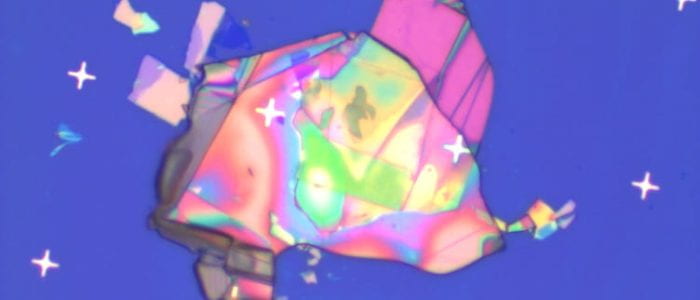 "Tropical fish" by Saif Siddique. hBN/RTe3/hBN heterostructure on SiO2 substrate.
"Tropical fish" by Saif Siddique. hBN/RTe3/hBN heterostructure on SiO2 substrate. "Peak 86 is a Bat" by Alyssa Xu (11.2021) Angle-resolved Raman spectroscopy of a noisy peak reveals a hidden bat.
"Peak 86 is a Bat" by Alyssa Xu (11.2021) Angle-resolved Raman spectroscopy of a noisy peak reveals a hidden bat. "Maple Leaf from Peak 104" by Alyssa Xu (11.2021). Angle-resolved Raman spectroscopy of a noisy peak resembles a Maple leaf.
"Maple Leaf from Peak 104" by Alyssa Xu (11.2021). Angle-resolved Raman spectroscopy of a noisy peak resembles a Maple leaf.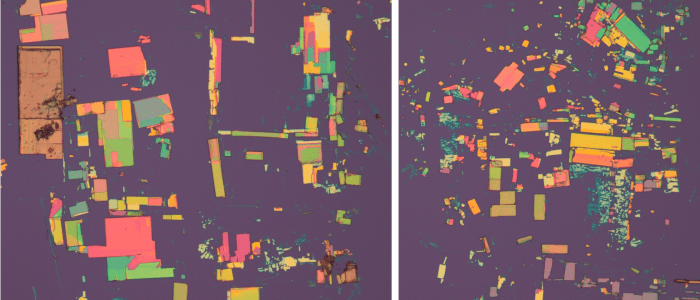 "Mosaic art with red phosphorus" by Mengjing Wang (3.2021). Flakes of red phosphorus of varying thicknesses colorfully decorate silicon oxide substrate.
"Mosaic art with red phosphorus" by Mengjing Wang (3.2021). Flakes of red phosphorus of varying thicknesses colorfully decorate silicon oxide substrate.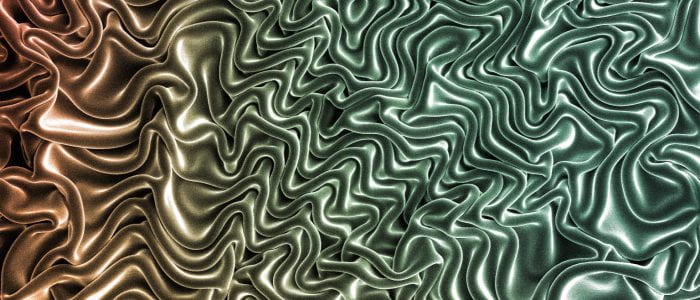 "Smooth silky waves" by Alyssa Xu (2.2020). A UV-cured, Li-electrolyte gets cross-linked under SEM. False-colored SEM image.
"Smooth silky waves" by Alyssa Xu (2.2020). A UV-cured, Li-electrolyte gets cross-linked under SEM. False-colored SEM image.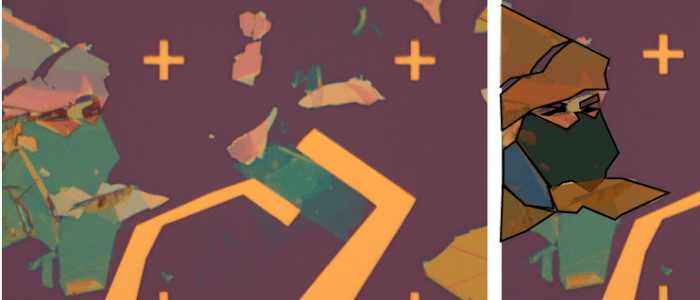 "Masked Japanese Samurai" by Sajad Yazdani (11.2019). A masked Japanese Samurai is on the watch during investigation 2D heterostructures.
"Masked Japanese Samurai" by Sajad Yazdani (11.2019). A masked Japanese Samurai is on the watch during investigation 2D heterostructures.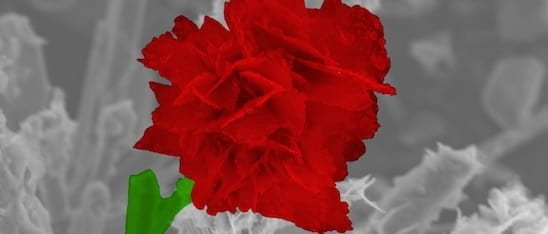 "Crystalline Rose" by Josh Pondick (6.2019). Petal-shaped MoS2 crystals during CVD. False colored SEM image.
"Crystalline Rose" by Josh Pondick (6.2019). Petal-shaped MoS2 crystals during CVD. False colored SEM image.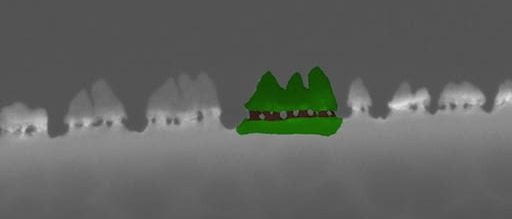 "Life on the Edge" by Josh Pondick (6.2019). Tree-shaped formations at the edge of a deep trench etched into silicon. False colored SEM image.
"Life on the Edge" by Josh Pondick (6.2019). Tree-shaped formations at the edge of a deep trench etched into silicon. False colored SEM image. "Radioactive MoS2" by Milad Yarali (7.2019) A monolayer MoS2 flake, where a central region started to grow a second layer. False colored SEM image.
"Radioactive MoS2" by Milad Yarali (7.2019) A monolayer MoS2 flake, where a central region started to grow a second layer. False colored SEM image.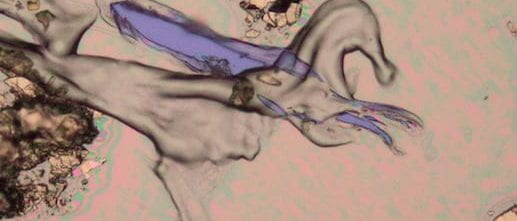 "Polymer Pegasus" by Josh Pondick (6.2019). Accidental winged-horse formation on a substrate from scratches (purple) and bulges (clear) in a PPC polymer film.
"Polymer Pegasus" by Josh Pondick (6.2019). Accidental winged-horse formation on a substrate from scratches (purple) and bulges (clear) in a PPC polymer film.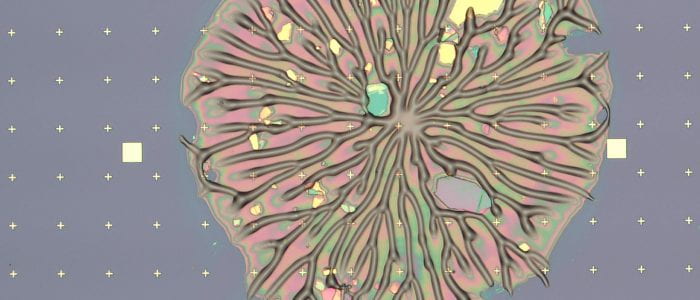 "PPC Coral Reef" by Sajad Yazdani (7.2019). Overheated PPC film during transfer of 2D films. The formation of dendrites can be explained by the constructal law that maximizes current flows, in this case heat current.
"PPC Coral Reef" by Sajad Yazdani (7.2019). Overheated PPC film during transfer of 2D films. The formation of dendrites can be explained by the constructal law that maximizes current flows, in this case heat current.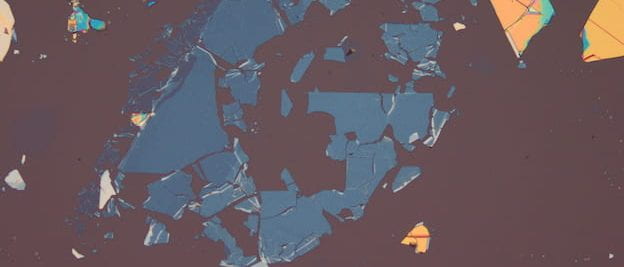 "Pac-Man in quarantine" by Mengjing Wang (9.2020) Flakes of hBN outline a Pac-Man that grew COVID-19 hair and beard during quarantine.
"Pac-Man in quarantine" by Mengjing Wang (9.2020) Flakes of hBN outline a Pac-Man that grew COVID-19 hair and beard during quarantine. The reason why tomography is important. (Drawing by John O'Brien @ 1991 The New Yorker Magazine)
The reason why tomography is important. (Drawing by John O'Brien @ 1991 The New Yorker Magazine)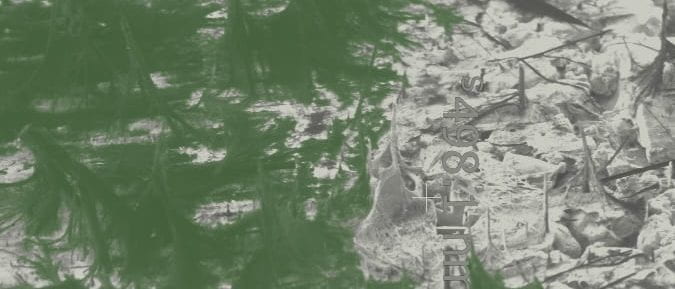 "In the wilderness with FeGe" by Saif Siddique (01.2024): walk in the forest of FeGe nanowire trees and aluminum oxide rocks
"In the wilderness with FeGe" by Saif Siddique (01.2024): walk in the forest of FeGe nanowire trees and aluminum oxide rocks "Stained Glass Window" by Saif Siddique (5/2025). Large-angle convergent beam electron diffraction (LACBED) pattern of a ~40 nm thick exfoliated ErTe3 flake. LACBED patterns are useful to study the crystallographic symmetries of samples.
"Stained Glass Window" by Saif Siddique (5/2025). Large-angle convergent beam electron diffraction (LACBED) pattern of a ~40 nm thick exfoliated ErTe3 flake. LACBED patterns are useful to study the crystallographic symmetries of samples.